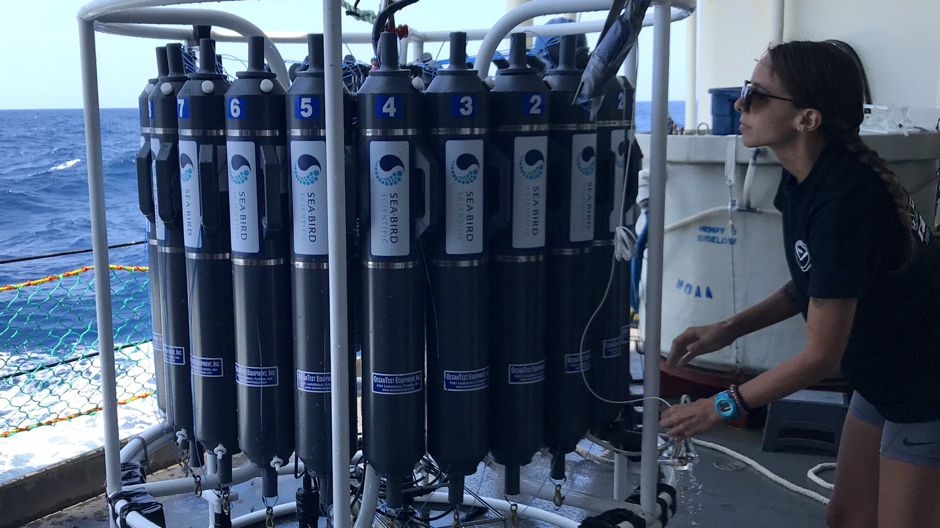My name is Emma Pontes, and I am one of 18 scientists serving on the East Coast Ocean Acidification research cruise (ECOA-II). Our goal is to understand the long-term effects of ocean acidification along the east coast of the United States. We accomplish this goal by regularly sampling and analyzing ocean water for several different chemical parameters including pH, alkalinity, dissolved inorganic carbon, methane, and many others. Because this is the second iteration of the ECOA cruise track, thus the name ECOA-II, we can compare our data to that of 2015 (ECOA-I) to understand how ocean chemistry has changed in the past three years. We hope to continue building a robust database that will illustrate the progression of ocean acidification, and serve as a comparison for future ECOA cruises.
What’s my role on the cruise?
My job on this cruise is to measure the dissolved oxygen concentration of water samples using a technique called Winkler Titration. This technique requires me to add a cocktail of caustic chemicals to my water samples which act as a fixative, binding to all available dissolved oxygen. You can think of it as ‘pickling’ the oxygen to preserve it, so that the water sample can be analyzed anywhere from one hour to four weeks after being collected. This bound oxygen appears as a cloud-like precipitate which eventually settles to the bottom of the sample (Figure 1). Once settled, I use an automatic titrator in combination with a computer program to determine the dissolved oxygen concentration of the sample. Dissolved oxygen is an important indicator of ocean acidification because it can be used to determine how ocean biology is functioning, as well as how much anthropogenic CO2has been sequestered by the world’s oceans.
A large piece of machinery called a CTD (conductivity, temperature, and depth; Figure 3) allows us to collect ocean water from multiple, specific depths so that it can be sampled and analyzed for many different chemical parameters. Sampling of the CTD is controlled chaos. It is an elegantly choreographed flurry of splashing water, shouting, avoiding skin contact with hazardous chemicals, and dolphin sightings. There is a strict order in which samples must be taken from the niskins (numbered bottles); because oxygen content quickly changes when seawater is exposed to air, I have the responsibility of sampling first. To date, my oxygen partner and I have collected and analyzedroughly 1,600 samples in just 26 days at sea.
Everyday life on the ship
Living and working at sea requires stamina, passion, and a strong stomach. Rough seas make simple tasks, such as walking down the passageway or pouring a glass of juice, a feat that requires focus, balance, and strength. Daily doses of dramamine, espresso, and sunshine help me power through my daily 12 hour shifts. Life at sea is best described as a perpetual Groundhog Day because we never deviate from our routine.
This is my third major research cruise, and my first on the R/V Henry Bigelow. As the second leg of our journey winds down, I can’t help but feel grateful that I get to collect meaningful data that will contribute to ocean acidification research with a fantastic group of scientists and crew who now feel like family.
About the author: Emma Pontes, M.P.S. is a research assistant in the department of marine biology and ecology at the UM Rosenstiel School.

